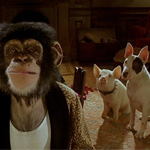 “So, will this little pink lunchness fulfill his destiny, nourishmentally speaking?”
“So, will this little pink lunchness fulfill his destiny, nourishmentally speaking?”
“We shall see.”
With BABE, writer-producer George Miller (and director Chris Noonan) created a warm little perfectly-told tale of a pig and a farmer finding happiness by violating social norms. (If that sounds gross to you, that’s not what I meant.) For the bigger, darker, weirder sequel, BABE: PIG IN THE CITY, Miller dropped the pure-hearted little pig into that world’s version of a noisy, chaotic metropolis, knowing he’d face the challenge with his head held high and make it out with his spirit intact, brightening lives along the way.
The Hoggett farm in BABE looks straight out of a storybook, but you figure that’s an anomaly. When the family comes over for Christmas, bringing modern attitude and technology, they seem to be visiting from the real world.
Maybe not, it turns out. Esme Hoggett (Magda Szubanski, who was only 37 at the time! Holy shit!) and “the wee pig” get stranded in a major city. They don’t say which one, but it’s whichever city that is where the skyline includes the Hollywood sign, the Sydney Opera House, the Golden Gate Bridge and the Eiffel Tower, among others. (No Space Needle, I’m afraid.) Garish billboards hang above picturesque canals and cobblestone roads. Most of the hotels don’t accept pigs, but they find one secretly housing a bunch of dogs, cats, chimps and an orangutan.
I gotta mention that this is the type of incredibly impressive production you’d hope for from the director of MAD MAX: FURY ROAD. These days talking animal movies like THE JUNGLE BOOK can be done with computer animation that looks like live action. In 1998, Miller had to build huge sets and create sophisticated, groundbreaking combinations of real animals, realistic puppets and digital touchups. It’s amazing to think about how difficult it must have been to have (or make it look like you have) that many different animals in a scene walking where they’re supposed to walk, facing where they’re supposed to face, looking like they’re in conversation.
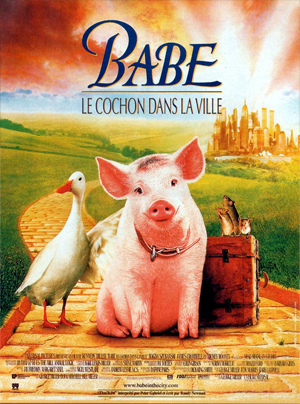 Mrs. Hoggett doesn’t leave the farm much, and this place is obviously overwhelming. Her husband (James Cromwell, SPECIES II) is injured from a well accident caused by Babe, bankers are trying to foreclose on the farm, and she’s taking advantage of Babe’s notoriety as a champion sheep pig to raise some money. But at the airport a dope dog showing off to Babe accidentally gets Mrs. Hoggett strip-searched and interrogated, causing them to miss their flight. This kind of stuff doesn’t happen back home.
Mrs. Hoggett doesn’t leave the farm much, and this place is obviously overwhelming. Her husband (James Cromwell, SPECIES II) is injured from a well accident caused by Babe, bankers are trying to foreclose on the farm, and she’s taking advantage of Babe’s notoriety as a champion sheep pig to raise some money. But at the airport a dope dog showing off to Babe accidentally gets Mrs. Hoggett strip-searched and interrogated, causing them to miss their flight. This kind of stuff doesn’t happen back home.
Babe’s introduction to city life is having to chase a monkey that runs off with Mrs. Hoggett’s suitcase. This could’ve gone a different way and it would’ve turned into the weirdest DEATH WISH ripoff ever. But instead of becoming a vigilante, Babe talks to the responsible group of circus performer apes, whose friendship he’ll eventually win over with his “kind and steady heart.”
There are many great new characters, but maybe the most distinctive is Thelonious (James Cosmo, HIGHLANDER), a very dignified suit-wearing orangutan whose whole vibe has always reminded me of John Houseman. He has a pet goldfish who he feeds and seems to see himself as above all the other animals and their shenanigans. In fact, I think he considers himself human. The others look up to him and call him “your honor.” He immediately turns his nose up to Babe.
Back home, Babe is a celebrity for winning the sheepdog championship. Before he was a nobody and a joke, now he has a trophy so they literally throw him a parade. As the narrator (Roscoe Lee Browne, UP TIGHT!, SUPER FLY T.N.T.) says fame makes it so that “those who once dismissed you as a lousy pork chop now clamor just to be in your presence.” Or as Tupac put it, “Gas me and when they pass me they used to diss me / harass me, but now they ask me if they can kiss me.”
But don’t worry, this is Babe we’re talking about, and all this nonsense has not changed him at all (unless you count his voice switching from Christine Cavanaugh to Elizabeth Daily [STREETS OF FIRE, THE DEVIL’S REJECTS]). And that’s good because in the city nobody fuckin cares. They see him as a naive hayseed. The chimpanzee named Bob (Steven Wright, RESERVOIR DOGS) tricks him into being bait for guard dogs while he steals a jar of jellybeans.
There are major cultural differences between the farm animals and the hotel animals. The apes and monkeys wear clothes. They have bigger vocabularies and love to play with language, including making up phrases like “this is insanitary” and “accusicating and making demandments,” or calling Babe “this naked pink individual.” They are indoor animals, only venturing outside in an emergency, and then hiding in the shadows at night. They have a cynical, every-animal-for-himself attitude. “It’s a dog eat dog world, and there’s not enough dog to go around,” explains Bob’s pregnant partner Zootie (Glenne Headly, DICK TRACY).
Unlike the farm animals, city animals have to fend for themselves. The apes exalt their clown human Fugly Floom (Mickey Rooney, SILENT NIGHT DEADLY NIGHT 5), who they call “Himself,” but he seems to be a senile alcoholic incapable of taking care of them. When the humans are away the animals have to desperately scrounge for “any edibles, any nibbly dibblies,” and don’t find much.
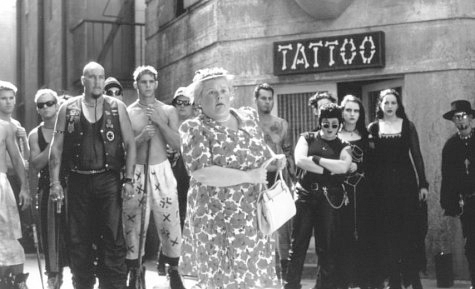 Mrs. Hoggett fits in even less outside among the humans. Jets roar overhead, looking like they’re almost scraping the buildings, drowning out conversations. In daylight the streets are crowded with people of all races and backgrounds, including bikers on rollerblades, beach bums, martial artists, jugglers, goths, cowboys and stilt-walkers. It’s like the opposite of her town’s rigid, judgmental uptightness. It’s a bunch of weirdos.
Mrs. Hoggett fits in even less outside among the humans. Jets roar overhead, looking like they’re almost scraping the buildings, drowning out conversations. In daylight the streets are crowded with people of all races and backgrounds, including bikers on rollerblades, beach bums, martial artists, jugglers, goths, cowboys and stilt-walkers. It’s like the opposite of her town’s rigid, judgmental uptightness. It’s a bunch of weirdos.
Babe is not one of these country people who come to the city and are scared of everybody. He’s one of the ones who has no idea of the dangers. Bob gets him to walk right up to this bull terrier (Stanley Ralph Ross, a writer on the Adam West Batman show) and doberman (also Ross) and talk to them. He is scared, but not too scared to have faith in his personal skills. He’s had to win over angry animals before (but with the “baa ram ewe” password).
“You must have a very thin grasp on reality,” says the doberman, more menace in his voice than pity.
The dogs chasing Babe is on the long list of great George Miller action sequences. It’s harrowing and includes a literal and figurative chain reaction: the dogs begin connected by a chain, which gets them caught on a pole, but the doberman unhooks himself, and the bull terrier drags it, and it gets caught on a push mower, which he tows around, and eventually the mower catches on something and he falls off a bridge and hangs from it, his face in the water so he might drown. Years ago when Miller was supposed to do a JUSTICE LEAGUE movie I got in arguments on the Ain’t It Cool talkbacks and I would tout PIG IN THE CITY as proof that he was still an action genius. Nobody bought it. Thank you, FURY ROAD, for indisputably proving my theory!
Watching this now, I can’t help but think of FURY ROAD as the disabled dog Flealick (Adam Goldberg, Fargo) is dragged from a track, or as Babe is chased through collapsing piles of junk. The scene also uses subliminal flashbacks, his life replaying before his eyes, very similar to Max’s flashes in FURY ROAD (they share an editor, Margaret Sixel).
But the beauty of the scene is not as much in the theatrics as the moving act of selflessness that it leads to. Babe is only safe when the bull terrier falls off the bridge. If it were Max, he’d speed away and never look back. But this is pre-poxy-clips. The whole community of hotel animals stand around and watch the dog hanging there, suffering, dying. They shake their heads and talk about what a shame it is to see something like this. “It’s the times, Nigel,” as the bulldog Allan (Eddie Barth, SHAFT) says. And they turn and walk away.
But we hear the pattering of hooves as Babe trots over and unhooks the chain, saving the life of the dog who was trying to kill him. Understanding the profundity of this act, the bull terrier immediately becomes Babe’s loyal bodyguard and enforcer, declaring him the new boss of the hotel. Babe is also recognized as a potential savior by the stray dogs and cats who saw the whole thing go down. They ask for his help and he (against the objections of the apes) lets them live in the hotel and share their limited supply of stolen jellybeans.
Babe doesn’t really know what he’s doing. He’s not trying to be the champion of the downtrodden. He’s just trying to be a nice guy, and that hasn’t been battered out of him yet. It usually works for him.
I have a friend who I recommended this movie to. She’s sensitive about dogs and was so traumatized by the bull terrier peril that to this day I’m afraid to ever bring the movie up with her. Others cite the scene where Flealick crashes and has a near death experience, briefly living what seems like a better life before snapping back and immediately getting back to work. For me the hardest scene to take is the raid on the hotel. The snooty neighbor Hortense (Julie Godfrey) – ironically tipped off by joyous singing in celebration of the birth of Zootie’s twins – calls animal control, who bust in with cages and lassos to take them all away. It’s like a SWAT team showing up at a wedding.
In this scene Babe performs another act of heroism: looped around the neck, he yanks himself away and escapes so that he can pick up a spilled goldfish in his mouth and spit him out the window into the canal. If Babe wasn’t such a sweetheart this rescue would make him seem like a total badass.
Most of the animals are captured, but not in a normal kids’ movie way, like a net falls over them or something. It’s a long sequence of frenzied escape attempts, scary armored humans coming after them, sad music by Nigel Westlake that kinda sounds like TITANIC. There’s a moment of the officers talking to each other, showing them as professionals doing a job, not bad guys, no cruelty intended. But otherwise we see them through the point of view of the animals, punching through the window, muzzling the bull terrier, tackling Bob to the ground.
Later we see the captive apes with their clothes removed, having mugshots taken. For the chimps it’s more natural, but Thelonious is humiliated. Somehow you see him as naked and vulnerable, as you would a human who had been arrested and stripped. No one is trying to harm him, but the system itself demeans him. It’s just designed that way. Tough luck, pal.
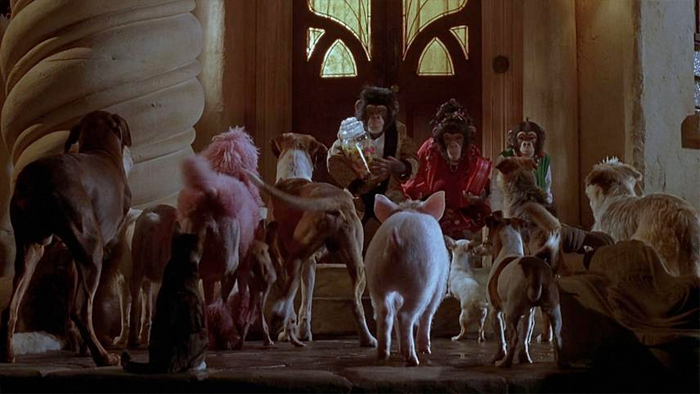
I don’t know if there have ever been any other cases to back this up, but the reception of BABE: PIG IN THE CITY makes it seem to me like maybe sometimes the American people make the wrong choice. The sequel was rejected by the public and made back less than a quarter of its budget. The good news is that, given time, we can wise up about these sorts of things. 18 years later its greatness is not so secret, and its reputation is more in line with some of its reviews (Gene Siskel chose it as the best movie of 1998, the last time he chose a best movie of the year).
Let’s talk about why I wanted to watch PIG IN THE CITY after Election Day. Last time I had what I thought at the time would be the worst political disappointment of my life I wrote a review of GARFIELD. So that’s where I was 12 years ago last week. It might be one of my best reviews, but this time I wanted to do something more positive and constructive and healing. For myself, if not for the world. And the first cheer-a-guy-up comfort movies that came to mind were the BABE saga.
I know this one has a reputation for being scary and fucked up for a G-rated family movie (they had to recut it to avoid a PG rating – fucking MPAA, man!), but Babe’s kindness cuts through all of that. Nobody dies (permanently), and everybody has a happy ending. (Well, I guess the poodle abandons her pups and the bull terrier to run off with another dog. But they seem to be surviving.)
More importantly, its themes include a couple things the election had put on my mind: the benefits of different types of people (or in this case animals) living together, and the differences between urban and rural living. It’s a fairy tale, but a fairy tale about ideals I think we should strive to live by.
I believe in a pluralistic society. I need it. You guys know what I write about, so you know most of my biggest fascinations – kung fu, hip hop, funk, soul, samurai movies – don’t come from my white ancestors. We learn from the expressions of others and apply their feelings and ideas to our own lives. Culture thrives by sampling a wide array of ideas and perspectives, and so does civilization. Equality and inclusion are not just about fairness to minorities, they make everyone’s lives richer. It’s weird that people don’t get that. And that goes not just for races, religions and nationalities, but classes and ways of life. Consider that if Babe had not gotten to understand the sheep community, he would’ve been a ham sandwich before ever making it to the city.
I like to think I’m pretty good at catching any of my internalized prejudices about race or gender and dealing with them. But I absolutely cop to too much of a negative attitude toward rich people, who haven’t necessarily done anything to me. And whenever these elections come out I have a festering resentment toward the rural communities that almost always lean more conservative than the cities. I think, who are you to fear African-Americans and Muslims, how often do you even see them? Who are you to complain about jobs when you make more money than me, and are trying to take away my health insurance? Who are you to judge our gay family and friends? Are you sure you didn’t chase them over here in the first place? Who are you to call our foreign policy and national security preferences soft on the terrorism that would most likely happen to us?
I stew about this stuff and then I wonder if this urban-left/rural-right divide happens because conservative people want to move out to the country, or if living in the city, around more people of different backgrounds, tends to make people more liberal? That you’re not gonna be so cavalier about people being on welfare if it’s your friend, or the family in front of you at the grocery store. That you care more about other people having health care if you see the people whose ailments go untreated without insurance. That you’re not gonna fall for this fear-mongering about immigrants when they’re a big portion of your community.
It’s like, you wouldn’t eat Babe if you knew him.
That’s usually my suspicion. But I know that’s not all fair, and not necessarily true. In Washington state, the east side of the mountains is the Republican part of the state, and also the only part where I’ve seen anti-Mexican graffiti. But this was in a town with a large immigrant community working in the apple industry, so my living-near-each-other-makes-you-understand-each-other theory didn’t seem to help out there. Unless it has to do with how close together the buildings are. Plus, I could name famously racist neighborhoods I’ve heard of in New York and Boston. Living in diverse cities didn’t enlighten some of those guys.
It is also true that living in the city you become desensitized to the suffering you see. Homelessness in Seattle has grown enormously in recent years. I see people in need every day and have long since accepted that I don’t know how to help them. It’s like, you have to feel bad every time you leave your apartment, or train yourself not to feel it too much. “It’s the times, Nigel.”
I stay up past 2 a.m. most nights, trying to write. My window overlooks a corner where every day or two I’ll see a mentally ill yelling fit, a drunken argument, a scuffle between a grocery store clerk and a shoplifter, or a bunch of police cars and ambulances. I should feel worse about it than I do. I should be less excited when it’s a crazy spectacle. I like the way that clerk threatens to put his foot up the guy’s ass, but the guy probly wouldn’t be running out with the two bags of groceries if he wasn’t starving.
PIG IN THE CITY’s city is kinda like that. Among the humans there’s clearly a huge class divide between the people walking around and the stodgy donors at the charity ball (whose money seems to support animal experimentation). Among the animals, there are the strays, who have been abandoned or mistreated by their humans, and the better-off hotel-livers, and only Babe could bring them together.
Everyone is cynical. Babe is the only one naive and pure enough to share what he has with the homeless. The others call them “freeloaders.” Bob complains that “We did all the work. We should get the biggest share.” (Of course, it was Babe who risked his life and made peace with a dangerous adversary.) They feel they have to “look out for number whatsy.”
This hopelessness is not just a city attitude, it’s everybody but Babe. Ferdinand (Danny Mann, HAPPY FEET TWO), also visiting from Hoggett Hollow, tries to discourage Babe from trying to rescue his new friends. “Face it, you’re just a little pig in the big city. What can you possibly do? What can anyone do? WHY EVEN TRY!?”
But good things can happen in the city. There’s an odd reoccurring thing where a human character (first an airport janitor, then a judge) does something that helps Mrs. Hoggett and Babe, and then his face is revealed and he has a weird pig nose. It’s never quite worked for me, but it has a moral that applies here. These are guys who have sympathy because of experience with pigs. Other instruments of the system – the men from the bank, the airport security agents, the police who seem to think Esme is talking to them when she yells “Pig!” – are exaggeratedly menacing and inhumane. The bankers have a literal storm cloud that follows them as they walk onto the farm. All of these people would be nicer to the Hoggetts and their pig if they spent more time around people/animals like them.
I wish I knew how to connect us all together like that, to heal this political divide, and this racial divide. Unfortunately, the movie doesn’t give us a workable fix for this whole racism thing. When the dogs and cats call each other slurs like “pussy” and “buttsniff,” the bull terrier just intimidates them into being nice to each other. You could argue that in some very minor ways PIG IN THE CITY is only a movie, and not an effective blueprint for solving all of our current problems. But I think we can at least hold it up as a shining example of a better way to live.
Hortense getting the hotel raided reminds me of Seattle’s churches and charities setting up tent cities for the homeless and receiving backlash from the neighbors. These people need a safer place to live – but what about my need to not have them around? The animals are pretty much gentrified out of the hotel (Miss Flume leases it out to a dance club), which should be a bummer ending. But the resulting “curious arrangement” is a happy one. As in Miller’s THE WITCHES OF EASTWICK, and FURY ROAD, a disparate group of characters having bonded and become a family or community together.
Today I get even more joy than I used to from this utopian ending. Miss Flume and Mrs. Hoggett seem to become best friends (a very good thing if you remember how judgmental Esme’s friends were in the first one), they use the hotel money to save the farm, and the hotel animals come to live with the farm animals, bringing their lifestyle of diversity with them. Remember, we were told in the first one that Babe had “an unprejudiced heart,” and the others have done their best to follow his example.
So now circus animals and alley cats are learning how shit goes down on the farm, and vice versa. It’s kinda the same as it used to be except there’s an orangutan who wears clothes and identifies as “His Honor” who helps with the laundry, and everybody’s better for it. The farm animals definitely never saw anybody like Thelonious before, but so what? He’s a good guy. Having him around will make things more interesting. He was a little jealous of Babe coming in and getting all the gratitude that he liked to get, but he got over it. He just wanted some respect. Everybody wants some of that.
There’s also a new generation of bull-poodles who have little poofs of pink fur and question their father’s attack dog values. Forever onward.
“And so it was,” says the narrator, “the pig brought the two worlds together. Two broken halves to make something afresh.” I wonder if there’s some way to do that with our blue coasts and red in-between, our cities and our boonies? I hope so, but I will always stand behind the approach where you welcome and respect people of all nationalities, religions and lack thereof, genders and sexual preferences, encouraging their input and contributions. The one that comes from what the first BABE called “an unprejudiced heart.”
I pledge to try my best to be like the pig, who is kind to everyone, creates bridges between cultures, fits in by not conforming, is not corrupted or defeated by the status quo of the farm or the city, and makes friends of enemies. This will be hard, because I’m angrier and pettier than Babe, and not as adorable. But at least I wasn’t raised to be bacon. I have less to overcome.
Right now, my goal is to glorify the type of world I want to live in. Based on what this new president has promised his followers, it seems like there’s a famous statue in New York that we should probly give back to France, or at least put a tarp over its inscription. Luckily the city from PIG IN THE CITY already has its own Statue of Liberty. I’ll work for a world without all this fear and division and resentment. I want to see families and communities as disparate as the skyline in Babe’s city, cultures mingling, sharing, collaborating, the world progressing. That is the way forward. That’ll do.

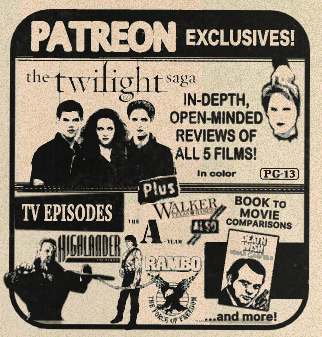
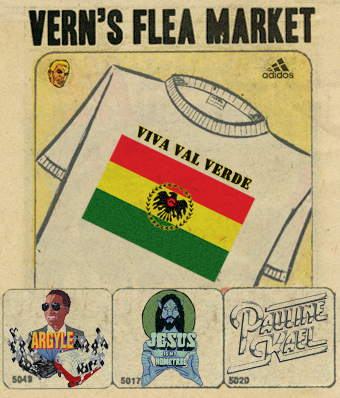
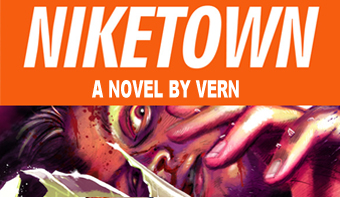
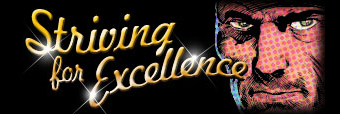
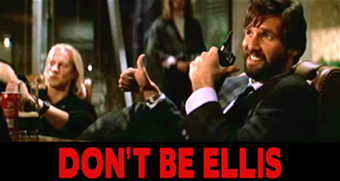
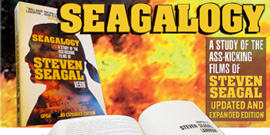
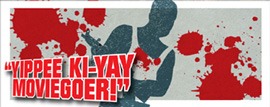








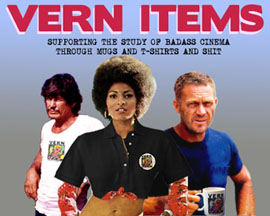
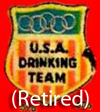
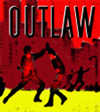






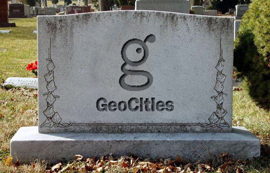
November 14th, 2016 at 1:37 pm
Whoa very deep review for a talking pig joint. Didn’t expect that. As for the movie itself: definitely the ALIENS to BABE’s ALIEN. Thank God there was never a BABE CUBED or BABE RESURRECTION. This may not have had the mainstream success of BABE but it did take those movies out on a high note.